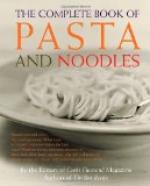This ancient jest has been somewhat improved in later times. Two Irishmen in the East Indies, being sorely pestered with mosquitoes, kept their light burning in hopes of scaring them off, but finding this did not answer, one suggested they should extinguish the light and thus puzzle their tormentors to find them, which was done. Presently the other, observing the light of a firefly in the room, called to his bedfellow, “Arrah, Mike, sure your plan’s no good, for, bedad, here’s one of them looking for us wid a lantern!”
Our specimens may be now concluded with what is probably the best of the old Greek jokes. The father of a man of Cumae having died at Alexandria, the son dutifully took the body to the embalmers. When he returned at the appointed time to fetch it away, there happened to be a number of bodies in the same place, so he was asked if his father had any peculiarity by which his body might be recognised, and the wittol replied, “He had a cough.”
[Illustration]
FOOTNOTES:
[1] Etienne Tabourot, the author of this amusing little book, who was born at Dijon in 1549 and died in 1590, is said to have written the tales in ridicule of the inhabitants of Franche Comte, who were then the subjects of Spain, and reputed to be stupid and illiterate. From a manuscript translation, entitled Bizarrures; or, The Pleasant and Witlesse and Simple Speeches of the Lord Gaulard of Burgundy, purporting to be made by “J.B., of Charterhouse,” probably about the year 1660, in the possession of Mr. Frederick William Cosens, London, fifty copies, edited, with a preface, by “A.S.” (Alexander Smith), were printed at Glasgow in 1884. I am indebted to the courtesy of my friend Mr. F.T. Barrett, Librarian of the Mitchell Library, Glasgow, for directing my attention to this curious work, a copy of which is among the treasures of that already important institution.
[2] “Wit and Mirth. Chargeably collected out of Taverns, Ordinaries, Innes, Bowling-greenes and Allyes, Alehouses, Tobacco-shops, Highwayes, and Water-passages. Made up and fashioned into Clinches, Bulls, Quirkes, Yerkes, Quips, and Jerkes. Apothegmatically bundled vp and garbled at the request of John Garrett’s Ghost.” (1635)—such is the elaborate title of the collection of jests made by John Taylor, the Water Poet, which owes very little to preceding English jest-books. The above story had, however, been told previously in the Bizarrures of the Sieur Gaulard: “His cousine Dantressesa reproued him one day that she had found him sleeping in an ill posture with his mouth open, to order which for the tyme to come he commanded his seruant to hang a looking glasse upon the curtaine at his Bed’s feet, that he might henceforth see if he had a good posture in his sleep.”
[3] Only a Liliputian steamer could go up the “river” Cart!
[4] “Seestu” is a nickname for Paisley, the good folks of that busy town being in the habit of frequently interjecting, “Seestu?”—i.e., “Seest thou?”—in their familiar colloquies.




